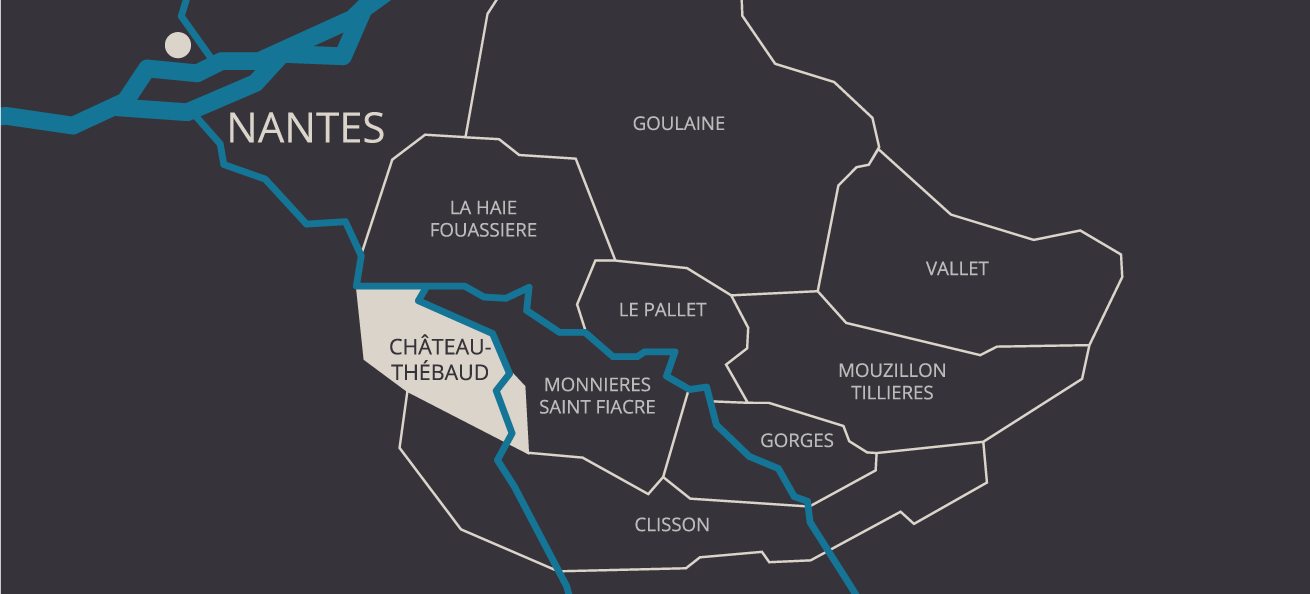Château-Thébaud,
A Muscadet Cru
Château-Thébaud, which lies a little south of Nantes in the heart of the Muscadet Sèvre et Maine winemaking area, is one of ten newly recognised cru appellations (crus communaux). This new village-based division of the Nantais winegrowing region is the result of a collective desire by local winemakers to promote the richness and diversity of Muscadet terroirs and the Melon de Bourgogne variety which is unique to this area. The Cru approach is based on the limitation of production to only the best identified vineyard plots, rigorous winegrowing requirements with limited yields, and lees-ageing of over two years to produce wines with a strong personality.
The extraordinary nature of the Muscadet terroirs is linked to the history of the Armorican massif, a mountain chain which formed 300 million years ago. Over the geological ages and with weathering, the massif has eroded, leaving a unique variety of outcrops of plutonic and metamorphic basement rocks that today form our subsoil, e.g. granite, gneiss, micaschist, gabbro, amphibolite, etc. The Loire and the Sèvre and Maine rivers are responsible for micro-climatic influences and have shaped mounds and slopes offering naturally well-drained soils with good exposure to sunlight. In the maritime climate of the Nantes region, these terroirs produce excellent white wines that are capable of ageing. Their freshness, intensity and aromatic complexity makes them the perfect partner for gastronomic cuisine.

The Granite of Château-Thébaud
Château-Thébaud is the smallest of the Muscadet Crus Communaux. It encompasses an area on both sides of the river Maine up to the confluence with the river Sèvre. Its relatively high vineyards offer open views of the surrounding landscape across to the bell towers of the neighbouring villages.
The appellation area lies on a lens of granodiorite, known as Château-Thébaud granite, and gneiss derived therefrom. Granodiorite is a plutonic rock, formed by the crystallisation of magma below the surface of the earth. It has a grainy texture similar to granite, although is darker in appearance, containing quartz, plagioclase feldspar, and mica. The Pont Caffino cliff along the Maine, below the village of Château-Thébaud, is an excellent place to observe this. To the south, the appellation is bounded by the Sillon de Bretagne, an important geological fault, which acts as a boundary with the Clisson appellation; to the north, the river Maine provides a natural separation from the Monnières-Saint-Fiacre appellation.
High Quality Winegrowing
In the vineyards of Cru Château-Thébaud, the weathering of bedrock has resulted in shallow soil that encourages early grape growth. It is naturally draining and has sandy clay at the surface. The ripening conditions are perfect and this presence of clay in the soil ensures good balance and freshness. The vineyards are looked after with painstaking care all year long. To produce wines that truly reflect their terroir, the soils are tilled and yields are limited to 45 hectolitres per hectare.
Château-Thébaud Wines
In the winery, Château-Thébaud wines undergo extended lees-ageing. The minimum requirement is 24 months, but 36 months is more common. Lees are the natural deposit left behind after alcoholic fermentation. After having completed the transformation of the grapes’ sugars into alcohol, the yeasts, which are natural microorganisms, die and form sediment that settles at the bottom of the vat. This sediment is known as the lees. Throughout the maturation period, the wine is enriched by numerous compounds upon contact with the lees and thus develops more complex aromas and body. Château-Thébaud wines are traditionally aged in glass-tiled underground vats, which offer optimum conditions thanks to their stable year-round temperature and protection from oxygen. The technique of bâtonnage, or stirring, which gently brings the lees back into suspension, is widely used.
The wines of Château-Thébaud show both a creamy character and minerality. On the nose, they display beautiful aromatic complexity dominated by candied citrus fruits, herbs (fennel, anise) and slightly smoky notes (gunflint, liquorice). The palate is full yet balanced by a clearly perceptible tension and a nice touch of bitterness. The terroir’s hallmark finish is saline and extremely long. Thanks to their natural tension, the wines are made to age. They are beautiful after a few years or can be cellared for 10 to 20 years.
Château-Thébaud wines are ideal with gastronomic cuisine, pairing very well with shellfish, cooked fish, spiced or Middle-Eastern dishes and goat’s cheese.
